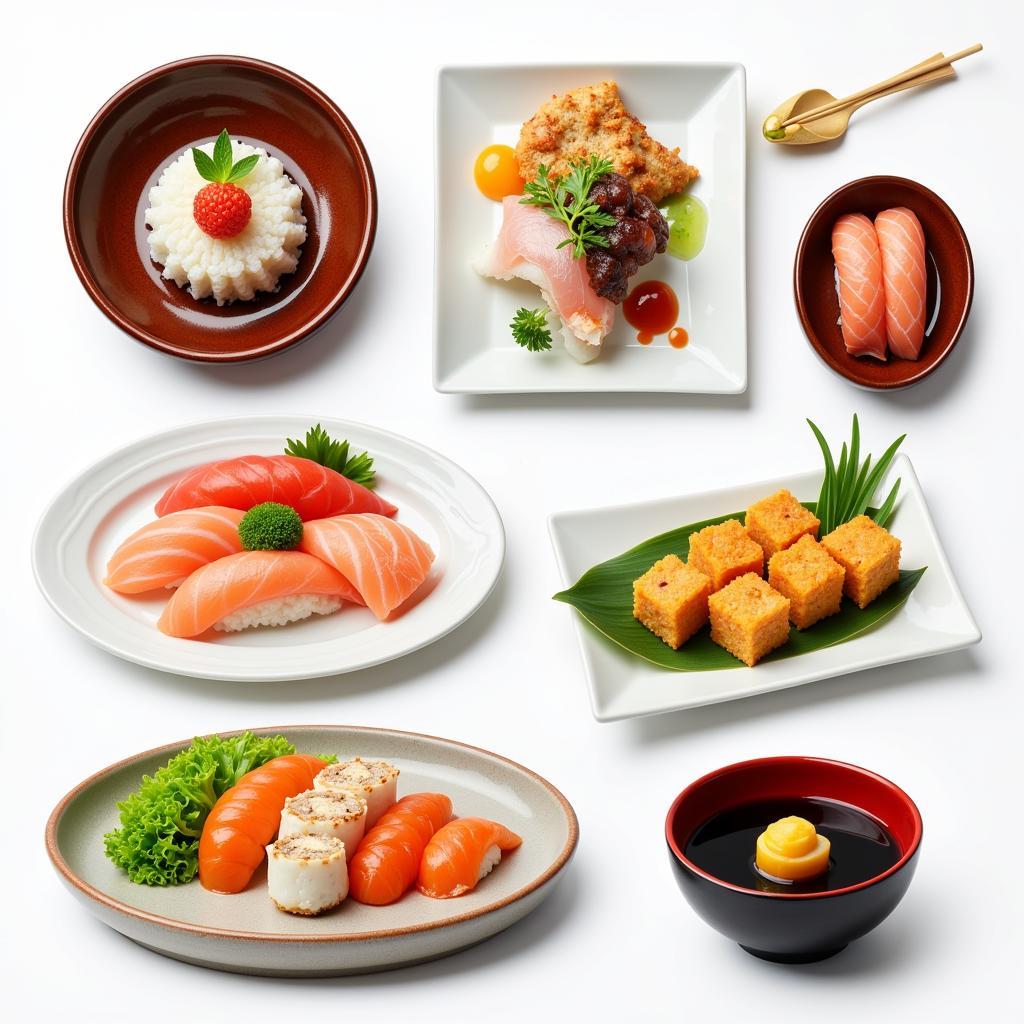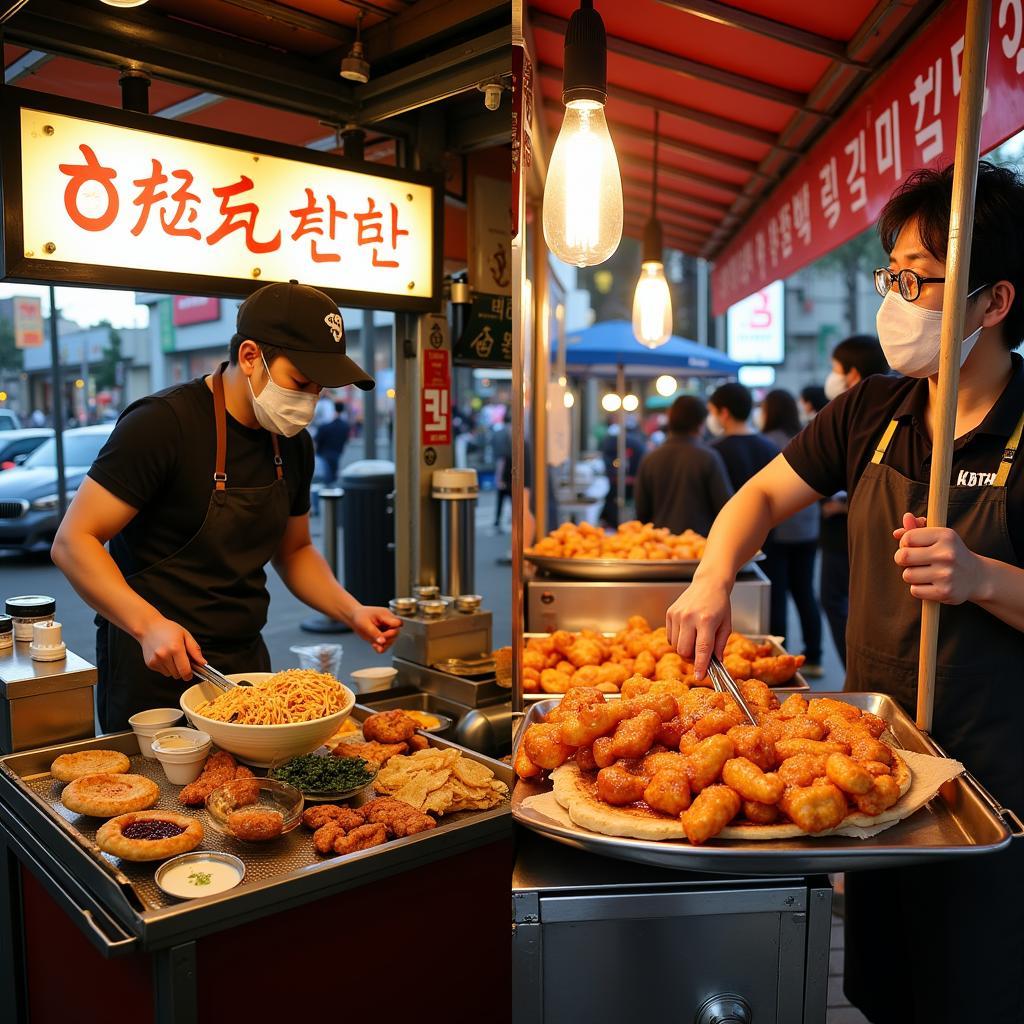Korean and Japanese cuisine – both are celebrated worldwide for their unique flavors, fresh ingredients, and artful presentation. While geographically close, their culinary paths diverge, creating two distinct and equally enticing food scenes. This article delves into the captivating contrasts and surprising similarities between Korean and Japanese food, offering a taste of what makes each cuisine so special.
A Tale of Two Flavors: Exploring the Core Differences
At their heart, Korean and Japanese cuisines prioritize fresh, seasonal ingredients. However, their approach to flavor profiles sets them apart. Korean food bursts with bold, pungent flavors, often characterized by a spicy kick. Think kimchi, the fiery fermented cabbage, or gochujang, the versatile and addictive chili paste.
Japanese cuisine, on the other hand, leans towards delicate, nuanced flavors, emphasizing umami, often referred to as the fifth taste. This savory depth is achieved through ingredients like soy sauce, dashi (a savory broth), and fermented foods like miso.
 Vibrant Spread of Korean Dishes
Vibrant Spread of Korean Dishes
Beyond the Spice: Key Ingredients and Cooking Techniques
The differences extend beyond flavor profiles. Rice, a staple in both cuisines, is prepared differently. Korean cuisine favors short-grain rice, resulting in a stickier texture, while Japanese cuisine utilizes short- and medium-grain rice, yielding a fluffier result.
Noodle dishes are ubiquitous in both cultures, but the types of noodles and broths used vary significantly. Korean cuisine features chewy noodles, often served in robust, spicy broths like in the popular dish, tteokbokki. Japanese cuisine showcases a wider variety of noodles, from thin soba noodles to thick udon noodles, served in lighter, more delicate broths as seen in ramen.
 Elegant Array of Japanese Dishes
Elegant Array of Japanese Dishes
Cultural Influences on the Plate
Both Korean and Japanese cuisines have been shaped by their unique cultural landscapes. Confucianism plays a significant role in Korean food, emphasizing balance and harmony in meals. This is evident in the concept of banchan, small side dishes served alongside rice and soup, creating a symphony of flavors and textures.
Japanese cuisine is heavily influenced by Zen Buddhism, reflected in the emphasis on simplicity, seasonality, and aesthetic appeal. The concept of “washoku,” recognized by UNESCO as an Intangible Cultural Heritage, highlights the importance of respecting nature and using seasonal ingredients in Japanese cooking.
Finding Common Ground: Shared Culinary Threads
Despite their differences, Korean and Japanese food share some similarities. Both cuisines value fresh seafood, often served raw, as seen in Korean hoe (raw fish) and Japanese sashimi. Both cultures have a penchant for fermentation, with Korean kimchi and Japanese miso showcasing the transformative power of this ancient technique.
 Side-by-Side Comparison of Korean and Japanese Street Food
Side-by-Side Comparison of Korean and Japanese Street Food
Korean vs Japanese Food: Which Will Tantalize Your Taste Buds?
Ultimately, the choice between Korean and Japanese food comes down to personal preference. Are you craving bold flavors and fiery spices? Korean food will set your palate on fire. Do you seek subtle, umami-rich dishes? Japanese cuisine will transport you to a world of delicate flavors. Whichever you choose, prepare yourself for a captivating culinary journey.
FAQ: Unraveling the Mysteries of Korean and Japanese Food
1. Is Korean food always spicy?
While Korean cuisine is known for its spice, not all dishes are fiery. There are plenty of mild and even sweet options available.
2. What is the difference between sushi and kimchi?
Sushi is a Japanese dish consisting of vinegared rice topped with seafood, vegetables, or other ingredients. Kimchi is a spicy, fermented Korean side dish made from cabbage, radishes, and various seasonings.
3. Do Koreans and Japanese eat rice with every meal?
Rice is a staple in both Korean and Japanese cuisines and is often served with most meals. However, it’s not uncommon to find dishes where noodles or other starches take center stage.
4. What are some popular vegetarian options in Korean and Japanese cuisine?
Korean cuisine offers delicious vegetarian dishes like japchae (glass noodles with vegetables), bibimbap (mixed rice with vegetables), and dubu jorim (braised tofu). Japanese vegetarian favorites include vegetable tempura, vegetable sushi rolls, and ramen with vegetable broth.
5. What are some must-try dishes for first-timers to Korean and Japanese cuisine?
For Korean food, start with bibimbap, kimchi jjigae (kimchi stew), and Korean barbecue. In Japanese cuisine, sushi, ramen, and tempura are great starting points.
Need help navigating the delicious world of Korean and Japanese food?
Contact us at Phone Number: 02437655121, Email: minacones@gmail.com, or visit us at 3PGH+8R9, ĐT70A, thôn Trung, Bắc Từ Liêm, Hà Nội, Việt Nam. Our 24/7 customer service team is always ready to assist you.
Explore more culinary adventures on our website! Check out our articles on [link to relevant article 1] and [link to relevant article 2].